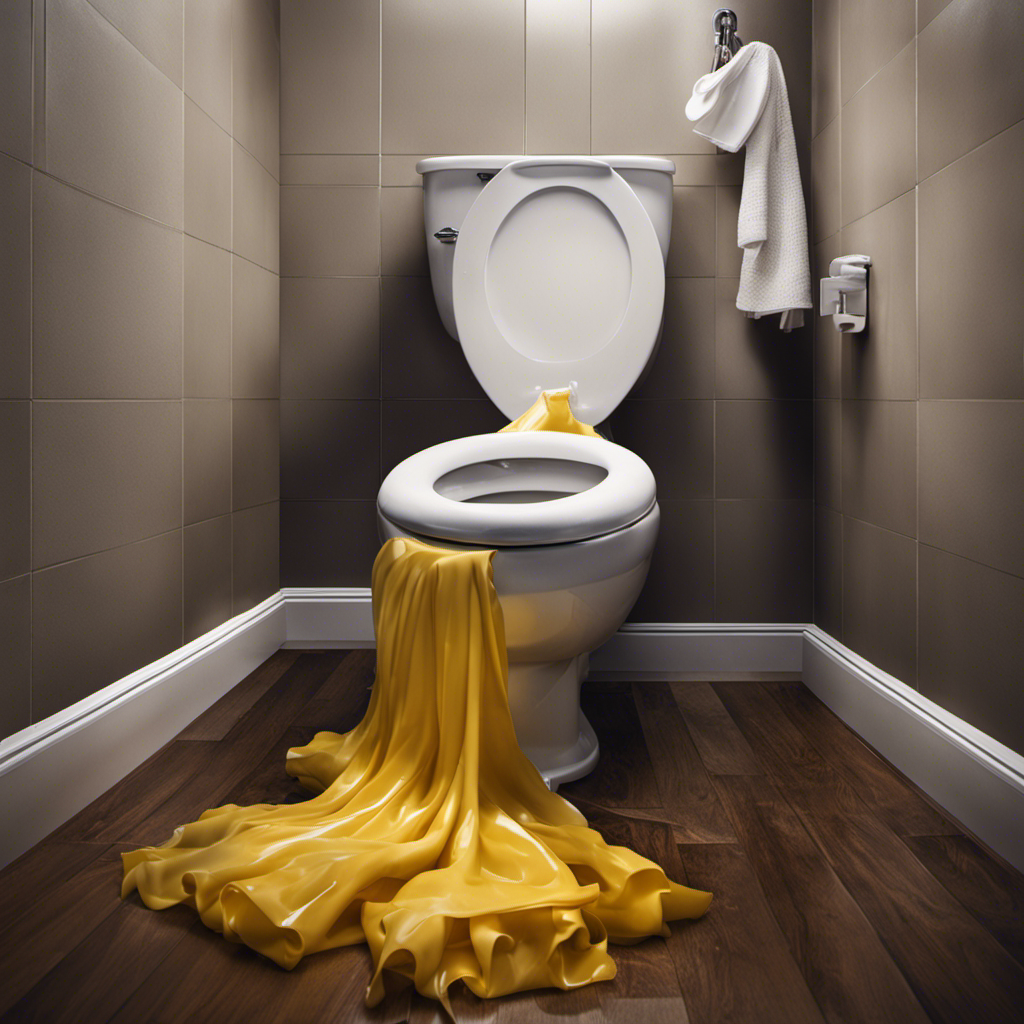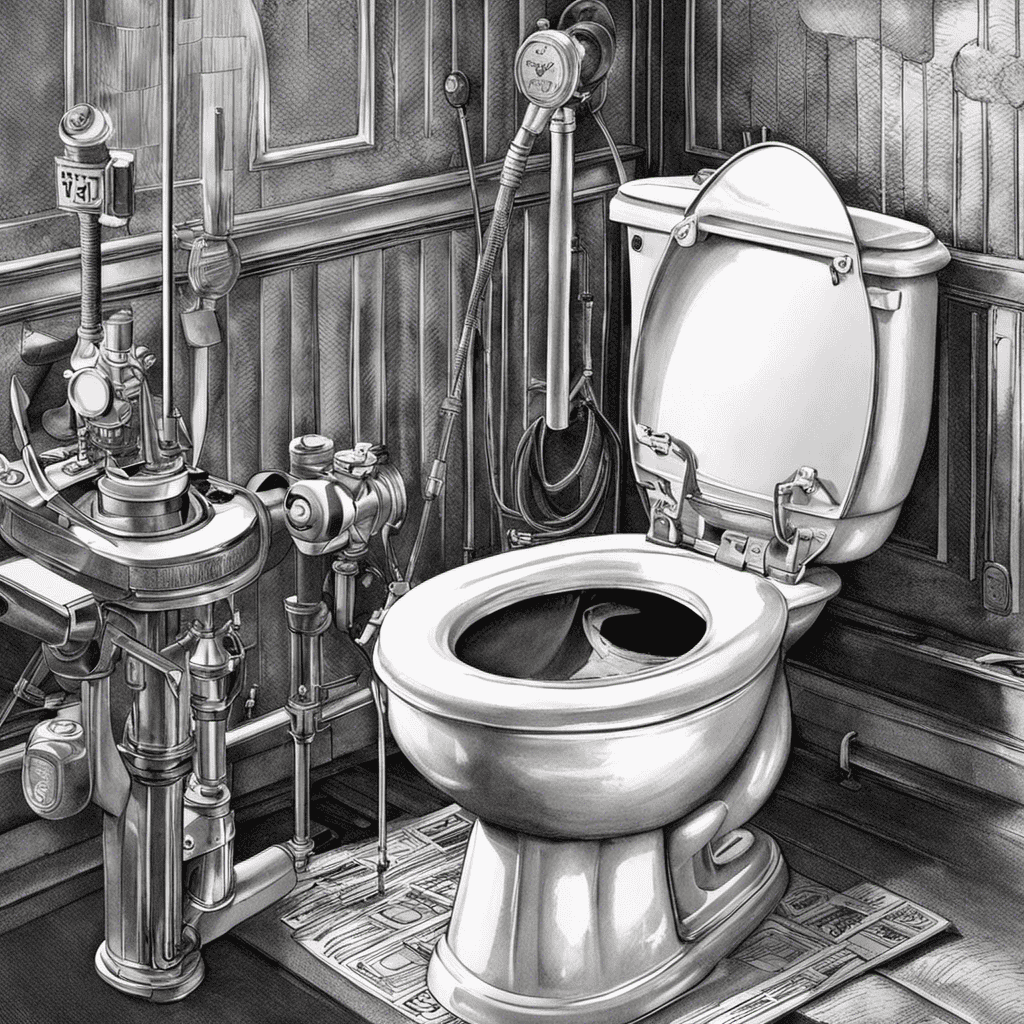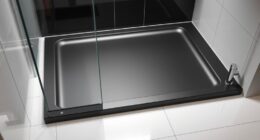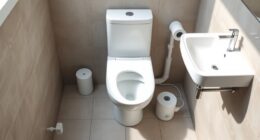Are you tired of dealing with a flooding toilet that seems to happen at the most inconvenient times? Don’t fret, help is here!
In this article, we’ll show you how to fix a flooding toilet in a few easy steps. From identifying the cause of the problem to preventing future mishaps, we’ve got you covered.
So, roll up your sleeves and get ready to tackle this pesky issue head-on. Let’s dive in and get that toilet back in working order!
Key Takeaways
- Check the water level and adjust the float if necessary
- Use a plunger or plumbing snake to clear a clogged drain
- Shut off the main water supply to prevent further damage
- Replace a worn or damaged flapper to fix toilet flooding
Identifying the Cause of the Flooding
Before you can fix a flooding toilet, you need to figure out what’s causing the problem.
There can be several causes of toilet overflow, such as a clogged drain, a faulty fill valve, or a malfunctioning float.
To identify the cause, start by removing the tank lid and checking the water level. If the water level is too high, try adjusting the float to lower it. If the water level is normal, the issue might be a clogged drain.
Use a plunger to try and clear the clog. If that doesn’t work, you may need to use a plumbing snake or call a professional for assistance.
Once you’ve identified the cause of the flooding, you can move on to the next step: shutting off the water supply.
Shutting Off the Water Supply
To prevent further damage and address the flooding, the essential first step is to turn off the water supply. By doing this, you can immediately stop the flow of water and minimize any additional harm to your property.
Locate the main water valve, typically found near the water meter, and turn it off by rotating it clockwise until it is fully closed.
Preventing Further Damage
You can start by turning off the water supply to the toilet to prevent further damage. To do this, locate the shut-off valve, which is usually located near the base of the toilet or on the wall behind it. Turn the valve clockwise until it is fully closed. This will stop the flow of water to the toilet, preventing any additional flooding and minimizing the risk of water damage.
Once the water supply is turned off, you can take further steps to address the emergency toilet repair. It is important to act quickly to prevent any potential damage to your home and belongings. Remember, if the situation becomes overwhelming or you are unsure of what to do, it’s best to contact a professional plumber for assistance.
Turning off Water
Once the water supply is shut off, it’s important to assess the situation and determine the extent of the damage. To prevent overflow and further damage, follow these steps to turn off the water supply:
-
Locate the shut-off valve: Look for a small valve near the base of the toilet. It is typically a silver or chrome knob connected to a water pipe.
-
Turn off the valve: Rotate the valve clockwise until it is completely closed. This will stop the flow of water to the toilet.
-
Test the water supply: Flush the toilet to ensure that the water is no longer flowing. If the toilet doesn’t refill, then you have successfully turned off the water supply.
Essential First Step
Before proceeding with any repairs, it’s important to locate the shut-off valve near the base of the toilet. This valve is crucial in preventing overflow and ensuring a quick response to the flooding issue. To find the shut-off valve, follow these steps:
- Look for a small, oval-shaped handle or knob on the wall or floor behind the toilet.
- Turn the handle or knob clockwise to shut off the water supply to the toilet.
By locating and turning off the shut-off valve, you can stop the flow of water to the toilet and prevent further flooding. Once the water supply is cut off, you can proceed with clearing the clog in the drain.
Now that you’ve successfully shut off the water, it’s time to move on to the next step of clearing the clog in the drain.
Clearing the Clog in the Drain
To start clearing the clog in the drain, grab a plunger and position it over the toilet bowl. Make sure the plunger is completely submerged in water.
Press the plunger down firmly, then pull it up quickly. Repeat this plunging motion several times, using steady pressure. The suction created by the plunger will help dislodge the clog in the drain.
If the water level starts to go down, continue plunging until the clog is completely cleared. Be patient and persistent.
If the clog doesn’t clear after a few attempts, you may need to try a different method or call a professional plumber.
Remember to clean and sanitize the plunger after use to maintain proper hygiene.
Fixing the Flapper or Flush Valve
When it comes to fixing the flapper or flush valve in your toilet, there are a few key points to keep in mind.
First, you’ll need to know the steps for replacing the flapper. This includes turning off the water supply, removing the old flapper, and installing the new one.
Second, troubleshooting the flush valve is important if you’re experiencing issues with flushing. This could include weak or incomplete flushes.
Flapper Replacement Steps
The first step in fixing a flooding toilet is checking to see if the flapper needs to be replaced. The flapper is a rubber valve that controls the flow of water from the tank to the bowl. Over time, the flapper can become worn or damaged, leading to leaks and toilet water overflow.
Here’s how you can replace the flapper:
- Turn off the water supply to the toilet.
- Flush the toilet to drain the water from the tank.
- Remove the old flapper by detaching it from the flush valve.
- Take the old flapper to a hardware store to find an exact replacement.
- Install the new flapper by attaching it to the flush valve.
- Turn the water supply back on and test the toilet for any leaks.
Troubleshooting Flush Valve
If the water in the tank is constantly running, it may be a sign that the flush valve needs troubleshooting.
The flush valve is responsible for controlling the flow of water from the tank into the toilet bowl during flushing.
To troubleshoot the flush valve, start by checking if the flapper is properly sealing the flush valve opening. A worn or damaged flapper can cause water to continuously leak into the bowl.
If the flapper replacement steps have already been followed and the issue persists, the next step is to troubleshoot the flush handle. Ensure that the flush handle is properly connected to the flush valve mechanism and that it is not stuck or obstructed.
If necessary, adjust or replace the flush handle to resolve any malfunction.
Proper troubleshooting of the flush valve and related components will help fix a flooding toilet.
Common Toilet Leak Causes
One common cause of toilet leaks can be a faulty flush valve. To prevent further damage and save water, it’s important to detect and fix these leaks promptly.
Here are some toilet leak detection and repair tips to help you get started:
-
Inspect the flush valve:
-
Listen for hissing sounds coming from the tank, indicating a leak.
-
Add a few drops of food coloring to the tank and wait for a few minutes. If the color appears in the bowl, you have a leak.
-
Check the flapper:
-
Ensure the flapper is properly seated and not worn or damaged.
-
Adjust the chain length to ensure it has enough slack to fully close the flapper.
By following these toilet repair tips, you can address common causes of leaks and prevent further water wastage.
Now, let’s move on to adjusting the water fill level to optimize your toilet’s performance.
Adjusting the Water Fill Level
To adjust the water fill level in your toilet, you’ll need to locate the fill valve. The fill valve is usually located on the left side of the toilet tank. Once you’ve found it, turn the valve clockwise to decrease the water level or counterclockwise to increase it.
Adjusting the water fill level is important because it helps control the water pressure in your toilet. If the water level is too high, it can cause the toilet to overflow or constantly run, wasting water. On the other hand, if the water level is too low, it may not effectively flush waste down the drain.
Preventing Future Toilet Flooding
Now that you’ve learned how to adjust the water fill level in your toilet to prevent flooding, let’s discuss some additional toilet overflow prevention tips.
By following these simple maintenance tips, you can avoid future toilet flooding and keep your bathroom clean and dry:
-
Regularly inspect the fill valve and flapper to ensure they’re functioning properly. If you notice any leaks or cracks, replace them immediately.
-
Ensure that the flapper is sealing tightly after each flush.
-
Avoid flushing excessive amounts of toilet paper or other non-flushable items. Use a waste bin for items such as cotton balls, tissues, or feminine hygiene products.
-
Schedule regular professional plumbing inspections to identify and fix any potential issues before they lead to toilet flooding.
Conclusion
In conclusion, you’ve successfully navigated the treacherous waters of a flooding toilet. Like a brave sailor battling a storm, you identified the cause, shut off the water supply, cleared the clog, fixed the flapper or flush valve, and adjusted the water fill level.
You have triumphed over the chaos, ensuring a smooth sailing future for your toilet. May your knowledge and skills in toilet repair serve as a beacon of hope for others facing similar challenges.










